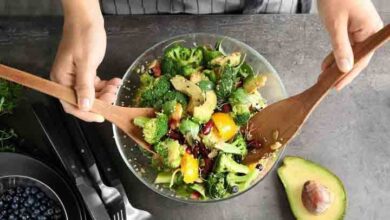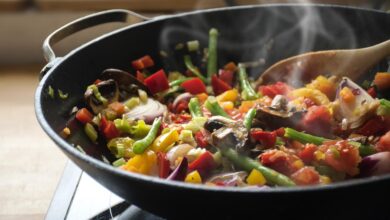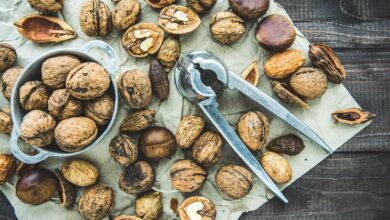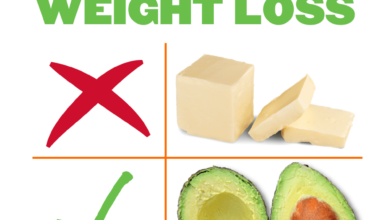
Everything You Need to Know About Chickpeas
Everything you need to know about chickpeas, from their humble origins to their starring role in countless dishes, is here. These little legumes, often called garbanzo beans, are a powerhouse of nutrition and flavor, making them a staple in kitchens worldwide.
Whether you’re a seasoned cook or a curious newbie, this guide will help you unlock the secrets of chickpeas and incorporate them into your culinary adventures.
From understanding their nutritional profile and exploring different varieties to mastering cooking techniques and discovering mouthwatering recipes, we’ll delve into the fascinating world of chickpeas. You’ll learn about their versatility, their role in various cultures, and their potential health benefits.
Get ready to discover why chickpeas deserve a spot on your plate, and maybe even become your new favorite ingredient.
Chickpea Basics
Chickpeas, also known as garbanzo beans, are a staple food in many cultures around the world. These legumes offer a delicious and nutritious addition to any diet, boasting a rich history and versatile culinary applications.
Chickpea Origin and History
Chickpeas originated in the Middle East, specifically in the region of the Fertile Crescent, which encompasses parts of modern-day Turkey, Iraq, Syria, Lebanon, and Israel. Archaeological evidence suggests that chickpeas have been cultivated in this region for over 10,000 years.
They were a significant part of ancient civilizations’ diets, and their cultivation spread across the Mediterranean region and beyond.
Nutritional Profile of Chickpeas
Chickpeas are a nutritional powerhouse, packed with essential vitamins, minerals, and macronutrients. Here’s a breakdown of their key nutritional components:
Vitamins and Minerals
- Fiber:Chickpeas are an excellent source of dietary fiber, which is crucial for digestive health and blood sugar control. A 100-gram serving provides around 15 grams of fiber.
- Protein:Chickpeas are a good source of plant-based protein, containing about 19 grams per 100 grams. This makes them a valuable addition to vegetarian and vegan diets.
- Folate:Chickpeas are rich in folate, an essential nutrient vital for cell growth and development, particularly during pregnancy.
- Iron:Chickpeas contain a decent amount of iron, a mineral crucial for oxygen transport in the body.
- Magnesium:Chickpeas are a good source of magnesium, a mineral involved in over 300 bodily functions, including muscle and nerve function.
- Potassium:Chickpeas are rich in potassium, an electrolyte essential for maintaining blood pressure and fluid balance.
Macronutrients
- Carbohydrates:Chickpeas provide a moderate amount of carbohydrates, mainly in the form of complex carbohydrates, which are digested slowly and provide sustained energy.
- Fat:Chickpeas are relatively low in fat, with most of it being unsaturated fats, which are considered heart-healthy.
Interesting Facts About Chickpeas
Chickpeas are not only nutritious but also remarkably versatile in cooking. They can be enjoyed in various ways, from being roasted and spiced to being ground into flour. Here are some interesting facts about chickpeas:
- Culinary Versatility:Chickpeas are a staple ingredient in cuisines worldwide, featuring in dishes like hummus, falafel, chana masala, and chickpea pasta.
- Global Popularity:Chickpeas are consumed in various cultures, including Indian, Middle Eastern, Mediterranean, and North African cuisines.
- Sustainable Food:Chickpeas are a sustainable food source, requiring less water and land than other protein sources, such as beef.
Types of Chickpeas

Chickpeas, also known as garbanzo beans, come in various types, each with unique characteristics that influence their culinary applications. These differences stem from factors like size, color, and texture, contributing to diverse flavors and cooking methods.
Types of Chickpeas
Chickpeas are broadly categorized into two main types: desi and kabuli.
- Desi chickpeasare smaller, darker, and have a rougher skin compared to kabuli chickpeas. They have a slightly earthy and nutty flavor, and their firm texture holds up well in cooking. Desi chickpeas are commonly used in Indian cuisine, especially in curries and stews, where their robust flavor and texture complement the rich spices.
They are also a popular ingredient in hummus, falafel, and chickpea flour.
- Kabuli chickpeas, on the other hand, are larger, lighter in color, and have a smoother skin. Their flavor is milder and slightly sweet, making them ideal for salads, soups, and roasted dishes. Kabuli chickpeas are often preferred in Middle Eastern and Mediterranean cuisines, where their delicate flavor and tender texture are valued.
Chickpeas are a powerhouse of protein and fiber, making them a fantastic addition to any diet. They’re versatile too, starring in everything from hummus to falafel. But with the rise of plant-based alternatives, it’s natural to wonder if these meatless options are truly healthier.
If you’re curious about the nutritional comparison between fake meat and the real deal, check out this insightful article on is fake meat healthier than the real thing. Back to chickpeas, they’re also a great source of iron and folate, making them a smart choice for those seeking a nutrient-rich addition to their meals.
They are also used in salads, dips, and as a topping for various dishes.
Chickpea Varieties
Within these two main categories, there are several varieties of chickpeas, each with distinct characteristics.
- Black chickpeas, also known as kala chana, are a type of desi chickpea. They have a dark brown to black color and a slightly bitter flavor. Black chickpeas are often used in Indian cuisine, particularly in stews and curries, where their unique flavor adds depth and complexity.
They are also used to make chickpea flour and are a good source of fiber and protein.
- Green chickpeas, also known as green garbanzos, are a type of kabuli chickpea. They have a bright green color and a slightly sweet flavor. Green chickpeas are often used in salads, soups, and as a side dish. They are also used to make hummus and falafel.
- Red chickpeas, also known as chana dal, are a type of desi chickpea. They are smaller than kabuli chickpeas and have a reddish-brown color. Red chickpeas are often used in Indian cuisine, particularly in stews and curries. They are also used to make chickpea flour and are a good source of fiber and protein.
- Yellow chickpeas, also known as chana dal, are a type of desi chickpea. They are smaller than kabuli chickpeas and have a yellow color. Yellow chickpeas are often used in Indian cuisine, particularly in stews and curries. They are also used to make chickpea flour and are a good source of fiber and protein.
Nutritional Content of Chickpeas
Chickpeas are a nutritious food, packed with protein, fiber, and various vitamins and minerals. The nutritional content can vary slightly depending on the type and variety of chickpea.
- Protein: Chickpeas are a good source of protein, with about 15 grams per cooked cup. This makes them a valuable addition to vegetarian and vegan diets.
- Fiber: Chickpeas are also high in fiber, with about 15 grams per cooked cup. Fiber helps regulate digestion, promotes satiety, and can help lower cholesterol levels.
- Vitamins and Minerals: Chickpeas are a good source of various vitamins and minerals, including folate, iron, magnesium, and zinc.
“Chickpeas are a versatile and nutritious food that can be enjoyed in a variety of ways. Their unique characteristics and nutritional content make them a valuable addition to any diet.”
Chickpeas are a versatile and nutritious legume that can be enjoyed in countless ways. From creamy hummus to crunchy roasted snacks, they offer a satisfyingly hearty addition to any meal. If you’re looking to incorporate more chickpeas into your diet as part of a weight-loss journey, consider checking out your 7 day guide to forming better habits for weight loss for some helpful tips and strategies.
Remember, chickpeas are packed with protein and fiber, making them a great choice for feeling full and satisfied while managing your calorie intake. So, go ahead and explore the delicious world of chickpeas – your taste buds and your waistline will thank you!
Cooking with Chickpeas: Everything You Need To Know About Chickpeas
Chickpeas are incredibly versatile, lending themselves to a wide array of cooking methods. Whether you prefer them soft and creamy or firm and crunchy, there’s a way to prepare chickpeas to suit your taste.
Chickpeas are a nutritional powerhouse, packed with protein, fiber, and essential vitamins and minerals. But when it comes to a low-carb diet, it’s crucial to understand that not all carbs are created equal. Why quality of carbs matters on a low carb diet is a topic worth exploring, as it helps us make informed choices about the types of carbs we consume.
So, while chickpeas are a good source of complex carbohydrates, they should be enjoyed in moderation on a low-carb plan, prioritizing other nutrient-dense options.
Soaking and Boiling
Soaking chickpeas before cooking helps to reduce cooking time and improves their digestibility. To soak chickpeas, rinse them thoroughly and place them in a large bowl filled with cold water. Cover the bowl and let the chickpeas soak for at least 8 hours or overnight.
After soaking, drain the chickpeas and rinse them again.To boil chickpeas, add them to a large pot of water and bring it to a boil. Reduce the heat to a simmer and cook for 45-60 minutes, or until the chickpeas are tender.
You can add a pinch of salt to the water during cooking.
Roasting
Roasting chickpeas brings out their nutty flavor and creates a crispy texture. To roast chickpeas, preheat your oven to 400°F (200°C). Rinse and drain the chickpeas, then spread them in a single layer on a baking sheet. Drizzle with olive oil, salt, and any other desired spices.
Roast for 30-40 minutes, stirring halfway through, until the chickpeas are golden brown and crispy.
Pressure Cooking
Pressure cooking is a quick and efficient way to cook chickpeas. Add the chickpeas and water to a pressure cooker, ensuring there is enough water to cover the chickpeas. Seal the pressure cooker and cook for 15-20 minutes, depending on the pressure cooker model.
Once the pressure is released, allow the chickpeas to cool before using them.
Tips and Tricks for Achieving the Perfect Texture and Flavor
- For a softer texture, cook chickpeas for a longer period. For a firmer texture, cook them for a shorter period.
- Add a pinch of baking soda to the cooking water to help soften the chickpeas and reduce cooking time.
- Season the chickpeas with your favorite spices and herbs during cooking to enhance their flavor.
- For a richer flavor, roast chickpeas with olive oil, salt, and spices.
- Use canned chickpeas as a convenient alternative to cooking dried chickpeas. Just rinse and drain them before using.
Culinary Applications of Chickpeas
Chickpeas are a culinary powerhouse, adding protein, fiber, and flavor to a wide range of dishes.
Salads
Chickpeas are a staple ingredient in salads, adding a hearty texture and protein boost. They work well in both simple and complex salads, such as:
- Mediterranean Chickpea Salad: Combine chickpeas with chopped cucumbers, tomatoes, red onions, feta cheese, and a lemon vinaigrette.
- Chickpea and Quinoa Salad: Mix cooked chickpeas with quinoa, chopped vegetables, and a light dressing.
- Chickpea and Potato Salad: A twist on the classic potato salad, featuring chickpeas, potatoes, celery, and a creamy dressing.
Soups and Stews
Chickpeas are perfect for adding body and flavor to soups and stews. They can be used in both vegetarian and meat-based recipes. Examples include:
- Chickpea Curry: A flavorful and comforting curry made with chickpeas, coconut milk, spices, and vegetables.
- Lentil and Chickpea Soup: A hearty and nutritious soup featuring lentils, chickpeas, vegetables, and broth.
- Spanish Chickpea Stew: A traditional Spanish stew featuring chickpeas, chorizo, vegetables, and paprika.
Dips and Spreads
Chickpeas are the star ingredient in many delicious dips and spreads. They can be blended into smooth and creamy dips or mashed into chunky spreads. Examples include:
- Hummus: A classic Middle Eastern dip made with chickpeas, tahini, garlic, lemon juice, and olive oil.
- Baba Ganoush: A smoky and flavorful dip made with roasted eggplant, chickpeas, tahini, garlic, and lemon juice.
- Chickpea Salad Spread: A simple and versatile spread made with mashed chickpeas, mayonnaise, mustard, and herbs.
Desserts
Yes, you read that right! Chickpeas can even be used in desserts. They can be ground into flour for use in cakes, cookies, and other baked goods.
- Chickpea Flour Brownies: These brownies are surprisingly decadent and have a fudgy texture.
- Chickpea Flour Pancakes: A healthier and gluten-free alternative to traditional pancakes.
Chickpeas in Recipes

Chickpeas, with their versatility and nutritional value, are a staple ingredient in cuisines worldwide. From hearty stews to light salads, they add texture, flavor, and protein to a wide range of dishes. This section explores the diverse ways chickpeas are incorporated into recipes, highlighting their global appeal and culinary significance.
Global Chickpea Dishes, Everything you need to know about chickpeas
The following table showcases popular chickpea recipes from around the world, highlighting their unique flavors and ingredients.
| Dish Name | Origin | Key Ingredients | Flavor Profile |
|---|---|---|---|
| Chana Masala | India | Chickpeas, onions, tomatoes, ginger, garlic, spices | Rich, savory, and aromatic with a blend of warm spices. |
| Hummus | Middle East | Chickpeas, tahini, lemon juice, garlic, olive oil | Creamy, nutty, and tangy with a hint of garlic. |
| Falafel | Middle East | Chickpeas, herbs, spices, onions, garlic | Crispy on the outside, soft and flavorful on the inside, with a blend of earthy and savory notes. |
| Chickpea Salad | Mediterranean | Chickpeas, vegetables, herbs, lemon juice, olive oil | Light, refreshing, and flavorful with a balance of tangy and savory notes. |
Nutritional Value of Chickpea-Based Dishes
This table compares the nutritional value of different chickpea-based dishes, highlighting their protein, fiber, and other key nutrients.
| Dish Name | Protein (g/serving) | Fiber (g/serving) | Other Key Nutrients |
|---|---|---|---|
| Chana Masala | 15-20 | 10-15 | Iron, magnesium, potassium |
| Hummus | 5-10 | 5-10 | Calcium, folate, vitamin E |
| Falafel | 10-15 | 5-10 | Iron, zinc, vitamin B6 |
| Chickpea Salad | 5-10 | 5-10 | Vitamin C, potassium, folate |
Final Review
So there you have it, a comprehensive guide to everything you need to know about chickpeas. From their history and nutritional value to their diverse culinary uses and health benefits, these humble legumes are a treasure trove of goodness. Embrace their versatility, experiment with different recipes, and enjoy the delicious and nutritious world of chickpeas!






